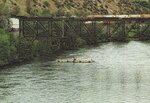
PATEROS – Motorists traveling north and south next spring on State Route 153 near the mouth of the Methow River at Pateros may not give a second look at an ordinary looking raft platform that will be anchored along the west bank of the river near the parking lot. The Methow River PIT detection raft is the latest collaboration between the Washington Department of Fish and Wildlife (WDFW) and Bureau of Reclamation (BOR) to study the Methow’s Chinook salmon.
About four years ago WDFW began working with the BOR to study the overwinter survival rates of Methow Chinook. The project began with multiple attempts to use radio tags implanted onto captured fish between 2018-2020 to collect data and estimate survival rates. However, in the course of overwintering the external tag antenna was often pulled loose in the rocks and did not remain with its host. When the radio tag data quantity and quality failed to provide adequate figures, the agencies transitioned to the more reliable Passive Integrated Transponder (PIT) microchip tags.
While PIT tag technology has been used for decades the detection raft is a new development by consultants with the Pacific States Marine Fisheries Commission. The barge measures about 46 feet wide by 16 feet long and is solar power equipped to run the on-board detection devices. Data from the PIT tags will download daily and an online link will later be made available where the public can also access the results.
The goal of the two agencies is to try to determine why egg-to-smolt survival is so low in the Methow and through the monitoring program come up with measures to increase survival rates. The more complete and comprehensive data gathered by the new detection technology will help fill in some of the gaps in information that WDFW/BOR needs to better understand overwintering survival.
“What we think is going on is a considerable amount of mortality,” WDFW biologist Andrew Murdock told the Pateros city council during a presentation at its July monthly meeting. “Anywhere between 40 and 60 percent of the fish die that first winter. The problem is that up until recently we have not had a good way of measuring it.”
Murdock was part of a three-man presentation team which also included WDFW Region 2 Director Brock Hoenes of Ephrata, and fellow biologist Chad Jackson.
Smolt traps have been deployed in the lower Chewuch and lower Upper Methow rivers and juvenile fish from the Twisp, Chewuch, and Upper Methow rivers. WDFW will tag 2,000 this fall and monitor the survivors next spring.
As soon as water and ice conditions permit next spring, the detection raft will be anchored near shore to begin its work.
Colville Tribes Fish and Wildlife (CTFW) has also been using PIT tags to study salmon survival rates as the fish travel through the Columbia River dams. Last May the CTFW personnel released 775 tagged salmon below Chief Joseph Dam as part of its efforts to reintroduce salmon to native waters above Chief Joseph and Grand Coulee dams.
Comments
No comments on this item Please log in to comment by clicking here